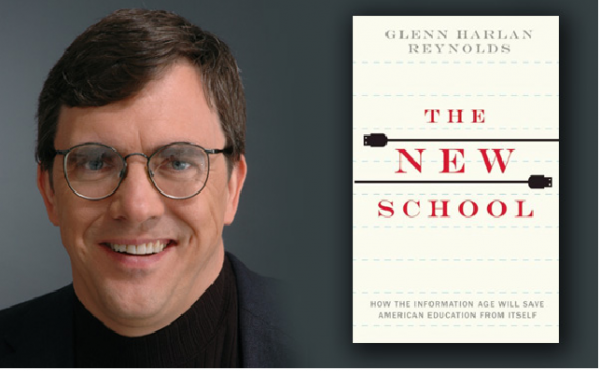
College Insurrection posts are often inspired by a pithy synopsis of campus news by Professor Glenn Reynolds (aka Instapundit).
So, with great joy, I wanted to share items from a new book featuring his wit, wisdom, and expertise on the subject of higher education, K-12 schooling, and possible technology-based transformations of how students learn that we may be seeing in the near future. One word for his newest publication, The New School: How the Information Age Will Save American Education from Itself: Compelling.
I am the mother of a 6th grader who is currently attending public school. While my son’s school is a good one, I find myself supplementing his education with trips to Kahn Academy (his math “coach” describes the program in a great article). A core theme in The New School is that online courses are one of the many new tools that will allow parents to customize an educational approach that makes sense for their children. In fact, he is an “early adapter” himself.
My daughter did most of her high school online, after spending one day in ninth grade keeping track of how the public high school she attended spent her time. At the end of eight hours in school, she concluded, she had spent about 2½ hours on actual learning.
Switching to online school let her make sure that every hour counted. The flexibility also allowed her to work three days a week for a local TV-production company, where she got experience researching and writing for programs shown on the Biography Channel, A&E, etc., something she couldn’t have done had she been nailed down in a traditional school. And she still managed to graduate a year early, at age 16, to head off to a “public Ivy” to study engineering.
My boy will be doing an online course on robotics, which is a developing interest of his. He just informed me he wants to invent the “warp drive.” This Halloween-time picture of us may explain why:
In fact, this burgeoning industry in educational customization is counter to the 19th century approach that was the basis for today’s American educational system, which was Prussian-inspired standardization during the Industrial Revolution.
Thus, the traditional public school: like a factory, it runs by the bell. Like machines in a factory, desk and students are lined up in orderly rows. When shifts (classes) change, the bell rings again, and the students go to the next class. And within each class, the subjects are the same, and the examinations are the same, regardless of the characteristics of the individual students.
Its creator, Horace Mann, actually homeschooled his children.
The fast-paced book is comprised of 50% on higher education and the numerous problems arising from the “bubble”, 25% on primary and secondary educational systems and their current challenges, and 25% on how new technologies are currently being implemented and projections for their future use.
While Reynolds offers no solid predictions, he does outline a clear battlefield that is developing: Between the education old-timers who will fight change, and the innovative entrepreneurs who will find pathways around the likely roadblocks that will be thrown in their way.
For those of you would would like more of an excerpt from Reynolds book, Minding the Campus has one that covers projected future scenarios for education: Shrinkage, Reconfiguration, Substitution, Exit, New Models.
As a Tea Party activist, I would like to summarize two savvy suggestions Reynolds makes:
To Students: Don’t go into debt.
To Parents: When your kids enter college, it is too late to change their college experience. Get involved with your local school boards, engage as college trustees and alumni, and become versed in institutional budgetary matters as best as you can now.
As Reynolds notes: Industries seldom reform themselves, and real competition comes from the outside. But if we’re lucky, I’ll be wrong about that, and higher education will play a big role in its own reinvention.
 DONATE
DONATE
Donations tax deductible
to the full extent allowed by law.










Comments
Public schools will go the way of the horse and buggy. The system has gone as far as it can go and new technology will allow students to go outside the current system to learn.
“Get involved with your local school boards”
This is a serious mistake in an otherwise great article. Getting involved in the board of a government monopoly bureaucracy school is a tragic waste of time. You are bound by decades worth of rules created by previous bureaucrats. You have control over only the small sliver of budget not covered by union contracts. You are stuck with kids whose parents aren’t interested in their responsibilities to their children. The state and federal governments can tell you what you can and cannot do. You will get sued by both sides of every issue. You will be in charge of Horace Mann’s failed “one size fits all” factory model of education. I’ve seen a good man knock himself out for years with no tangible results and no appreciation from the vast majority of the people he was trying to help.
Oh! You meant “Get involved with your local _private_ school board!” Sure, go ahead.
I have to agree.
Our substandard public schools were being run by an “old school” education establishment type of school board. When the public finally had enough, we elected mostly reformers to the board.
The result? Barely noticeable. The reformers go in with a head of steam and balls of fire, but the establishment tames them, moderates their desire for reform, and in the end converts them.
Since the schools still suck, and this is repeated in place after place, the only conclusion is that government control is toxic.
You can not “coexist” with the beast.
You must slay the dragon.
But, but, but….wasn’t common core suppose to fix this?
Sarc
Leslie, the link from “he is an “early adapter” himself.” is not working, at least not for me.
I did read the article once before but I wanted to review it again.
Thanks.
It appears logical to break the county wide system and return to one school board for one school. The huge district model has merely served the entrenched interests largely by using a class warfare model, “that school spends more money per student than my school therefore they should give me some of their money.”
With a single board for each school those parents who care, be it malignant or positive, will be closer to the actual product and producer. With the large model the parent has been squeezed out of the local school and tossed on the ash heap of a huge federally funded jauggernaut whose inertia is to protect its own little fiefdom with lots of cash. By limiting the jauggernaut the locals can peck away at the silliness, create an atmosphere where more and more parents become interested and come to agreement with the individual school as to what “experimentation” can and should be attempted.
Alas, this is not a cure all as we have found that small fiefdoms can flourish in a small enclave yet it will only harm a small area. What we see now is that large feifdoms harm larger areas.
When I attended engineering school, each of us had to learn how to set up and operate lathes and milling machines, weld with both gas and electric arc, cast metal by several methods, bend sheet metal, solder electronic circuit boards, and various other hands-on disciplines. I’m having difficulty understanding how such things can be learned on a computer.
I guess we live in “modern times” when people in other countries do those “dirty jobs” for us and we Americans no longer need to get our hands dirty.
Thomas Sowell in his book Conflict of Visions provides the liberal’s (those of the “unconstrained vision”) thought process. This thought process would certainly include using modern “expertise” to guide public education:
From Conflict of Visions Part One, Chapter Four, “Visions of Social Processes” he writes quoting from Dahl and Lindblom’s “Politics. Economics and Welfare,” U of Chicago, 1967 about this modern “expertise”:
“Third-party decision–making plays a key role: “Delegation to experts has become an indispensable aid to rational calculation in modern life.” What is “desirable” or “unsatisfactory” are referred to in passing, without explanation, as apparently things to obvious to require explanation (I am reminded of the Obama admin). “Needs” are also treated in the same way. There are analogies given to engineering or “scientific” social decision-making by third-parties:
‘“Bureaucracy itself is a method for bringing scientific judgments to bear on policy decision; (I think of the Obama admin’s use of Cass Sunstein’s “Nudge”) the growth of bureaucracy in modern government is itself partly an index of the increased capacity of government to make use of expert knowledge.”’
“This modern promotion of the use of experts echoes a tradition which goes back at least as far as the eighteenth century, when Condorcet saw the physical sciences as providing a model which the social sciences should follow. Indeed, he used the term “social science,” and urged that quantification and theories of probability be used in formulating social policies.
***
That being said, home school your children. Be your own expert. Kids need both upper and lower story knowledge, both Continental and Analytic thought.
John Stuart Mill in talking about “the antagonism separating the two traditions: The lower story, with its materialism, “is accused of making men beasts” while the upper story, with its irrationalism, is accused of making men lunatics.”
Kids need facts and values, nature and grace. The machine and the host (Descartes). Kids need the Lord of Rationalism and Romanticism